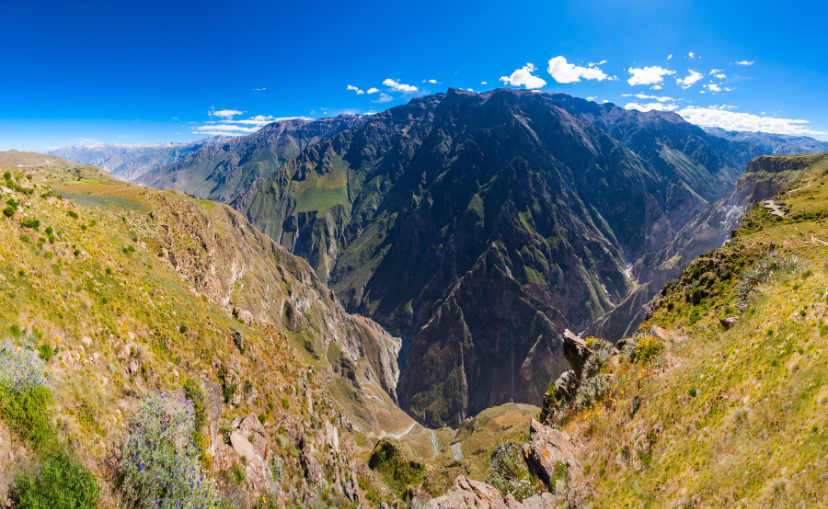19 Mind Blowing Natural Wonders In South America
Discover South America's most beautiful Natural Wonders.

South America is home to some of the most beautiful natural wonders on this planet. Here’s a list of 19 must-see natural wonders in South America.
Angel Falls

Angel Falls stands as the world’s tallest waterfall, dropping an incredible 3,212 feet from the summit of Auyán-Tepui. Reaching the falls, located deep in the Venezuelan jungle, is a true adventure, requiring both a plane ride and river travel. The sheer force and beauty of this natural marvel make it a must-see.
Learn more about Angel Falls.
Salar de Uyuni

This endless white expanse, the world’s largest salt flat, stretches across over 4,000 square miles in southwest Bolivia. During the rainy season (January to March), the flats become a giant mirror, reflecting the sky in such a way that it’s hard to tell where the horizon begins. It’s a mesmerizing experience that feels otherworldly.
Check out our Guide for Visiting Salar de Uyuni
Iguazu Falls

Iguazu Falls is located at the tri-border of Argentina, Brazil, and Paraguay. This system of 275 waterfalls is one of the world’s most breathtaking sights, dwarfing Niagara Falls and boasting a wider stretch. The most famous section, Devil’s Throat, delivers a heart-pounding view of nature’s power.
Galápagos Islands

The Galápagos Islands are a nature lover’s dream. Located about 600 miles off Ecuador’s coast, this volcanic archipelago is home to a host of unique species, many found nowhere else on Earth. The islands were central to Darwin’s theory of evolution, making them not only a biodiversity hotspot but also historically significant.
Learn more about the Galápagos Islands.
Torres del Paine

In Chilean Patagonia, Torres del Paine National Park offers dramatic granite peaks, shimmering lakes, and vast glaciers. Whether you’re hiking the famous W trek or simply admiring the views, the jagged towers of rock rising sharply from the landscape are sure to leave an impression.
Learn more about Torres del Paine.
Atacama Desert

The Atacama Desert, the driest non-polar desert in the world, spans northern Chile with its otherworldly landscapes of salt flats, volcanic geysers, and dunes. The extreme aridity makes it one of the best places on Earth for stargazing, especially during winter when the skies are clearest.
Learn more about the Atacama Desert.
Amazon River

The Amazon River is the largest by volume and arguably the most significant river system in the world. Spanning over 4,300 miles, it cuts through the dense Amazon Rainforest and supports one of the most diverse ecosystems on the planet. Its vastness and role in the continent’s geography are truly staggering.
Learn more about the Amazon River.
Perito Moreno Glacier

The Perito Moreno Glacier, one of the world’s most accessible glaciers, is an awe-inspiring sight located in southern Argentina. It’s part of the Southern Patagonian Ice Field, and visitors can watch as massive chunks of ice periodically calve into Lake Argentino, creating a natural spectacle.
Learn more about the Perito Moreno Glacier.
Colca Canyon

Twice as deep as the Grand Canyon, Peru’s Colca Canyon is a magnificent natural wonder. Aside from its size, it’s also known for being one of the best places to observe Andean condors in their natural habitat. The cultural terracing along the canyon’s walls adds to its unique beauty.
Learn more about Colca Canyon.
Lake Titicaca

Lake Titicaca, the world’s highest navigable lake, sits at an elevation of 12,507 feet in the Andes. Straddling the border of Peru and Bolivia, the lake is known for its crystal-clear waters and its cultural importance to the indigenous people. A visit to the floating islands, made entirely of reeds, offers a glimpse into a traditional way of life. These islands are completely manmade—created by the indigenous Uros people—for at the time what was protection against attacks from the Incas.
Aconcagua

Aconcagua, the highest peak in the Western Hemisphere, towers at 22,841 feet above the Andes between Argentina and Chile. It’s a favorite among climbers, offering both challenging and scenic routes to the summit. The snow-capped peak stands as a symbol of South America’s immense geological wonders.
Learn more about Aconcagua.
Laguna Colorada

This shallow, red-colored lagoon in Bolivia is rich in algae that give it its unusual hue, attracting thousands of flamingos each year. It’s a major stop for travelers exploring Bolivia’s Southwest Circuit and provides an unforgettable backdrop for photographs with its striking red waters and birdlife.
Learn more about Laguna Colorada.
Kaieteur Falls

Although less famous than some other waterfalls, Kaieteur Falls in Guyana holds the title of the world’s largest single-drop waterfall by volume. The sheer power of the water tumbling over a 741-foot cliff is awe-inspiring. The surrounding rainforest remains largely untouched, providing a pristine backdrop for the falls.
Learn more about Kaieteur Falls.
Tierra del Fuego, Argentina

At the southernmost tip of South America, Tierra del Fuego is known as the “End of the World.” This rugged, windswept archipelago shared by Argentina and Chile is characterized by forests, mountains, and glaciers. Visitors often explore Ushuaia, the world’s southernmost city, and the harsh, beautiful landscapes that surround it.
Learn more about Tierra del Fuego.
Mount Roraima

One of the most mystical places in South America, Mount Roraima is a flat-topped mountain (tepui) located on the tri-border of Venezuela, Brazil, and Guyana. The table-top summit, often shrouded in clouds, inspired Sir Arthur Conan Doyle's "The Lost World." The sheer cliffs and misty surroundings make it seem otherworldly.
Learn more about Mount Roraima.
Marble Caves of Patagonia

Located on the shores of General Carrera Lake in Chilean Patagonia, the Marble Caves are a stunning network of natural, marble-lined caverns. Formed over 6,000 years by the lake’s wave action, these smooth, swirling formations glow beautifully in the water’s reflection, creating an unforgettable visual experience.
El Tatio Geysers

Located in the Andes Mountains of northern Chile, El Tatio is one of the highest geyser fields in the world. With more than 80 active geysers, this geothermal area is a marvel to witness, particularly during sunrise, when the cold air enhances the steam columns rising from the earth.
Learn more about the El Tatio Geysers.
Chapada Diamantina

Chapada Diamantina National Park in Brazil’s Bahia state is famous for its stunning cliffs, caves, and waterfalls. With towering plateaus and lush valleys, the park offers diverse hiking trails. The enchanting beauty of its subterranean rivers, particularly the blue pools of Poço Encantado and Poço Azul, add to its appeal.
Learn more about Chapada Diamantina.
Los Roques Archipelago

This pristine national park off the coast of Venezuela is made up of over 300 islands and cays, offering some of the most beautiful beaches in the Caribbean. Known for its vibrant coral reefs and crystal-clear waters, Los Roques is a paradise for snorkeling, diving, and relaxing by the sea.
Learn more about the Los Roques Archipelago.
Not A Member? ✈️
Save 40%-95% On Flights With Jetsetter Alerts Airline Mistake Fare & Flash Sales Alerts!
Other Popular Post














